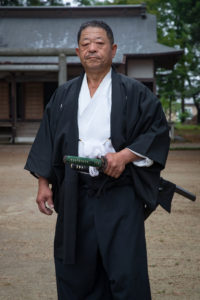
As far as I know the phrase Iwama Style, did not exist while Kaiso, the founder, Morihei Sensei was alive.
How come this phrase is now widespread among Aikido people all over the world? There is no doubt that it naturally began to be used by a lot of uchideshis who visited Iwama. They are people who were inspired by keikos in Iwama, whose atmosphere was completely different from what they had experienced until then.
In Kaiso’s lifetime, Japanese were living through turbulent times. Shortly after World War II ended, Morihiro, my father, became a pupil of Kaiso, and was training with Tohei Sensei, who had returned from the war and went to Iwama from his home in Tochigi prefecture.
At that moment, Iwama was little-known and there was no uchideshi from overseas. My father started to accept uchideshis little by little, and to go abroad in order to hold seminars.
For other students of Kaiso, they were desperate to eat after the war. Even though they were called by Kaiso, they had to give priority to cultivate their fields in order not to starve to death. Eventually they came to join keiko less and less often.
My father and mother kept serving Kaiso and his wife to the point where they would faint due to illnesses. In the meantime, many people came to Iwama and offered to help them. Nobody could, however, stay for several days or even for one or two days, which shows that it was not that easy to work under Kaiso.
For my father, he was lucky to be ablt to train alone with Kaiso. He must have been so happy to train weapon techniques in between helping Kaiso in the fields that He would feel like his fatigue from the field was taken away.
When Kaiso visited a Judo dojo in Nagoya, he said to the teacher of that dojo, “You should come to Iwama after I die.” After Kaiso passed away, that teacher invited my father to teach in his dojo. At the party after keiko, that teacher said, “Today I understood the meaning of Kaiso’s words which he gave me when he was alive.” My father didn’t know that Kaiso left such words until he was informed by that Judo teacher, and tears didn’t stop streaming down from his eyes. My father often told me about this story.
I’m so proud of my father, who had continuously served Kaiso for 24 years since he was 19 years old, and mother as well. They dedicated their whole life to Kaiso protecting his spirit and technique, Aiki Shrine and Ibaraki Dojo. I want to meet them with a smile in afterlife. I will not be able to show my face to Kaiso or my parents unless I leave something to honor the life and work of my great father, Morihiro Shihan. The meaning of building the monument* would be reduced by half if I accomplished it only by myself. This is why I would like to praise my father publicly with everybody who honors him. We will let you know once we decide on the details including the production cost next year. We kindly ask for your cooperation.
Hitohira Saito Headmaster of Iwama Shinshin Aiki Shurenkai
岩間神信合気修練会長 齊藤 仁平
* Sensei is refering to the project of erecting a commemorative monument dedicated to Shodai (the first) Morihiro Saito Sensei in front of the Tanrenkan dojo in Iwama
Translation by Nakajima Miki
